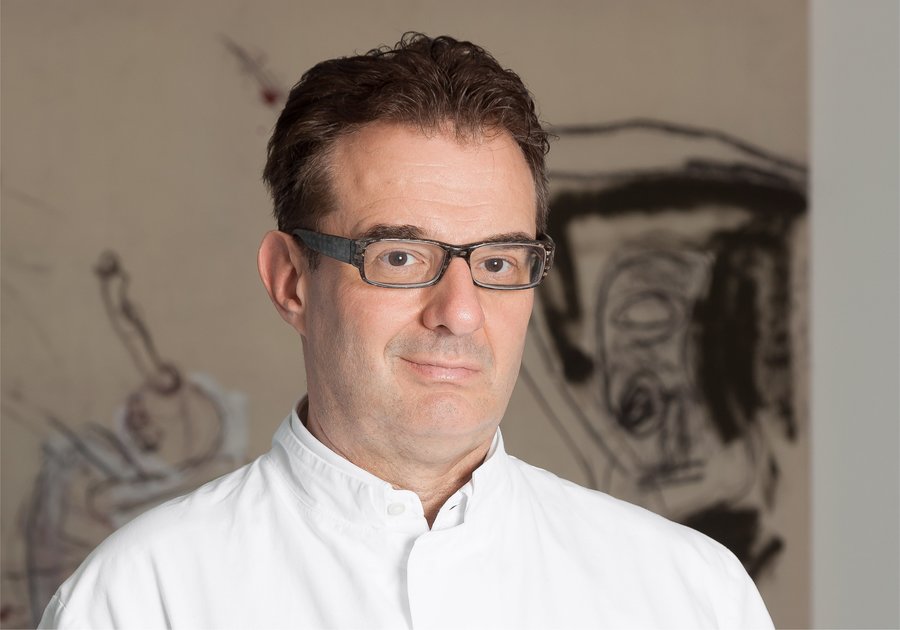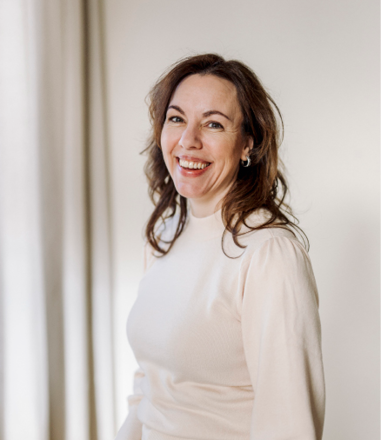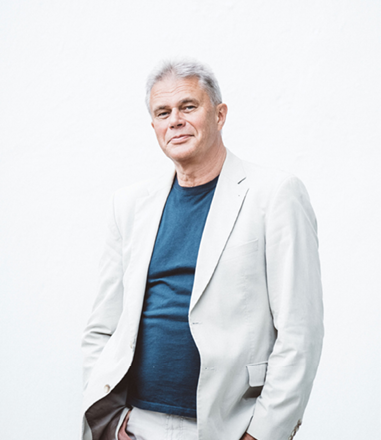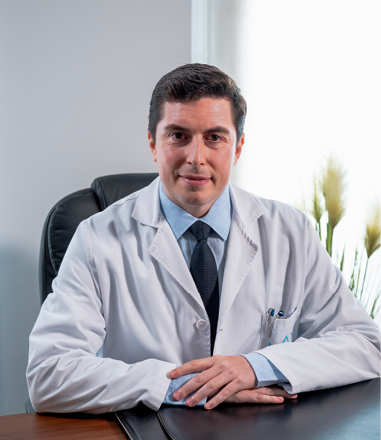Prof. Dr Manfred Tetz from Berlin is Ophtec's 2019 'Artisan Ambassador'. We asked him about his career, his clinic and why he prefers the iris fixation technique over other fixation methods.
In the heart of Berlin, on the Spree river, close to the city centres of former East and West Berlin, is the ‘Augentagesklinik Spreebogen’ eye clinic. This is the domain of Prof. Manfred Tetz. From this clinic and two annexes, together with three other ophthalmologists, he offers a large number of treatments that include Artisan and Artiflex lens implantations. For years now his preference has gone to these lenses, in both the phakic and the aphakic variant, over other models in the market. This preference is solidly based on research and studies. Training courses are regularly organised at the ‘Augentagesklinik Sprebogen’, as Prof. Tetz not only implants the lenses but also enthusiastically shares his immense knowledge and experience with Artisan and Artiflex.
An interview:
Can you describe your clinic?
Prof. Tetz: ‘My Berlin clinic is at a beautiful central location in the city. It is close to the Kurfürstendamm and the Tiergarten, five minutes from the central train station and 15 minutes from the Tegel airport. Good accessibility is important because not only locals but also patients from all over Germany and abroad come here for treatment.
My wife and I designed the clinic and came up with the procedures. The connecting thread was, what do we like in a clinic when we go to the doctor. For example, I detest large waiting rooms or people sitting in hallways. So you will not find that here. We aim to have a manageable and well-maintained clinic without the feel of a hospital. There are two other locations in addition to the Berlin clinic: Lutherstadt Wittenberg and Bitterfeld. I also have a space for my Berlin Eye Research Institute, where I am involved in clinical studies. Because I didn’t stop thinking after I left university.’
What treatments can patients come to you for?
‘I am a traditional full-blooded eye surgeon with a lot of experience. People can come to the clinic for a wide variety of treatments. I focus on the anterior segment, but not exclusively. I do keratoplasty and glaucoma, and I am an expert in canaloplasty. Patients come to Berlin for these procedures from all over the world. We also do a lot of refraction work, 50 percent laser and 50 percent lenses. We do all kinds of lenses: phakic lenses, lenses for refractive lens exchange, as well as standard cataract lenses.
In recent years we have also treated many trauma patients from war zones, for example, explosion victims from Libya. To summarize, you could say that we do everything except whatever does not belong in an outpatient setting, such as vitreoretinal surgery.’
In 2003 you decided to stop with your work at the university and start your own clinic – why did you take this step?
‘In 1998 I came to Berlin for a position at Charité, a renowned hospital and the largest university hospital in Europe. Ophthalmology changed in the years that I worked there. An increasing number of ophthalmological treatments were being performed on an outpatient basis at private clinics, so ophthalmology departments at hospitals shrank, merged or were altogether eliminated. I had seen this trend begin years earlier in the United States when I was studying there. In 2003 I decided not to stay behind, to look ahead to the future and go with the trend. This is why I started my own clinic.’
You have been using Artisan and Artiflex lenses for years – can you tell us why?
‘I have been using the Artisan lens for over 20 years for many purposes, and Artisan and Artiflex for refraction surgery for over 15 years. I have implanted a considerable number of phakic lenses.
And I will tell you why:
Early on in my studies, I spent two years in the United States, thanks to a special scholarship I was eligible for, the Feodor Lynen scholarship, part of the Humboldt Foundation. For the research I did in the United States I went to the David J. Apple Laboratory, an ophthalmology research lab that focused on IOL-related pathology. I worked on chamber angle-fixated lenses. I saw thousands of histological sections of eyes with chamber lenses that had been removed for medical or other reasons. The problems were clear: chronic inflammations, erosion of the loops in the ciliary body with chronic lymphatic tissue infiltration. None of these eyes, not even the so-called autopsy eyes, eyes that had accepted lenses, were free of inflammation. That opened my eyes in an early stage of my career: the chamber angle is the wrong place to fixate a lens. The major problem is the size of the lens. If the lens is too big, the tissue against which the lens is supported begins to erode, resulting in chronic inflammation. If the lens is too small and moves, that movement can cause inflammatory reactions.
My conclusion: an IOL should never be fixated in the area of the moving ciliary body - not in the anterior chamber and not in the posterior chamber. Those were lenses with a diameter of 14 mm, which is too large for the anterior segment. That has changed now, but we still see that sizing remains an important problem with such lenses.
At that time I also saw some pathologies and autopsies of eyes with Artisan lenses. The lens was only fixated to the iris at two points and no inflammation was visible, not even at the site where the lens was fixated. The eyes were calm. Iris fluorescein angiography subsequently showed that there was no extravasation of fluid at the fixation site either, which could be a sign of damaged vessels. For me, it became clear: the only way to attach a lens to an eye in the absence of capsular support or as an addition to a natural lens is iris fixation. That was never a question for me.
Sometimes I explain it to my patients, and then I say: “Imagine a wall to which you want to hang a picture. The picture must cover the entire wall exactly. If you make the slightest mistake when measuring, the picture will be just too big or just too small, and it will not fit. You can also make the picture a lot smaller and hang it on part of the wall. The picture will then never be too big or too small. And that is exactly what we have with the Artisan and Artiflex lenses.” The 8.5-mm lens is considerably smaller than the anterior segment, so it never touches the tissue of the chamber angle or the tissue in the region of the ciliary body where a muscle moves.
In the last 25 years a lot of different models of phakic chamber angle-fixated lenses have been introduced to the market, but they have all disappeared. Not a single one survived because they all had the same problem: sizing, pupil ovalisation, inflammatory reactions or endothelial cell loss. The only other lens that survived is a posterior chamber lens, in fact, a truncated contact lens, the ICL. This lens clamps between the iris and the natural lens. The risk of developing cataracts with this lens, at least in the models leading up to the current model, is between 4 and 17 percent in published studies. There are even studies that mention a percentage of 30 to 40 percent. But I find that even a chance of 4 percent, or cataracts in a 25-year-old, is too high, and that is the reason why I only use Artisan or Artiflex for phakic eyes. My percentages for cataracts are very close to zero percent. Sometimes I see a sort of nuclear sclerosis after 15 to 17 years, but in a 57-year-old person who has worn lenses for 17 years the nuclear sclerosis could have also developed because of the high myopia, you just don’t know. Cataracts can develop sooner with high myopia.
To sum it up: of all the different models of phakic lenses that have been introduced only two remain, the lenses of the Artisan and Artiflex family and the ICL. For me personally, if I compare the two, Artisan and Artiflex have better safety records.’
Who do you consider eligible for a phakic Artisan or Artiflex lens?
‘Many clients come here and have been told at a laser institute that they are not eligible for laser treatment and are looking for another option. Hyperopes from +4 and hard myopes from 8 or 10 and higher, that is the first group. The second group is made of clients with an average myopia of 3, 4 with a type of keratoconus. I tell them that laser treatment would be dangerous for their cornea and that a phakic lens is a safer solution.
The third group has problems with the corneal thickness and is therefore not eligible for laser treatment, but is eligible for a lens.
And then you have another group with one eye eligible for laser but not the other. For instance, one eye is 5 and the other 10. There are a couple of options for those people. One is a combination of laser and lens. I have dealt with that decision about ten times. It is a very interesting group because after everything has healed and all is behind them, you can ask them which is now their better eye in terms of healing and everything related to it. Only they can say something about that difference between laser and lens. The answer? So far no one from that group chose laser. Everyone preferred the eye with the lens. It is of course only a small group, but I find the outcome very interesting.’
In what cases do you use the Artisan Aphakia lens?
‘I use the Artisan Aphakia lens for aphakic eyes that have little capsular support and as a secondary lens. More than 10 years ago I stopped attaching posterior chamber lenses when there was insufficient capsular support. For these cases, I use the Artisan Aphakia lens and prefer retropupillary fixation, because there seems to be slightly less lens movement and it appears to be slightly better, optically speaking. Of course, not all these eyes have perfect vision after treatment because of macular problems or problems caused by trauma, previous surgery or anything else. I also do what you could call ‘crazy stuff’. I treat patients without an iris, traumatised eyes and eyes with complete aniridia. I have a handful of patients on whom I have implanted an artificial iris with an Artisan lens attached to it. This is very rewarding work because those patients had an eye that was hardly being used due to the aniridia. After the operation, they have an eye out of which they can see and which also looks normal on the outside. If I do one or two of these treatments in one year, I’m happy the whole year. These are exceptions and often long operations, but they are worth it.’
Once or twice a year you give Artilens training in collaboration with Ophtec – how do you go about it?
‘Most of the time there are one or two participants interested in the implantation of phakic lenses. They are mostly more experienced surgeons that want to add the technique to their arsenal. Phakic implantations need practice; you need to develop a feel for it because the challenge lies in not making any mistakes in a phakic eye that could cause cataracts or endothelial cell loss.
The largest group wants to know what you should do in complicated cases or how you do a good secondary implant. I always look at the needs of the participants.
The course is set up for both groups, but in recent years I have focused more on how to perform a good anterior vitrectomy and how to place a secondary implant there because there is more of a need for that knowledge in daily practice.’
In addition to your life as an ophthalmologist, do you have time for other things? What do you do in your free time?
‘I am very interested in a lot of different things, but unfortunately, my free time is limited. Of course, my family is very important, they come in the first place.
My whole life I have been involved with rescue dogs, giving shelter to stray dogs and adoption dogs. Right now I have five of them at home, and on weekends I like to take them to the woods. My wife and I also try to make a small contribution to a better world. We support national and international good causes, including a small village in Brazil, and paying for the education of a child in India. Little drops on the hot stones’.
Also published in Ophtec's magazine OphTheRecord




